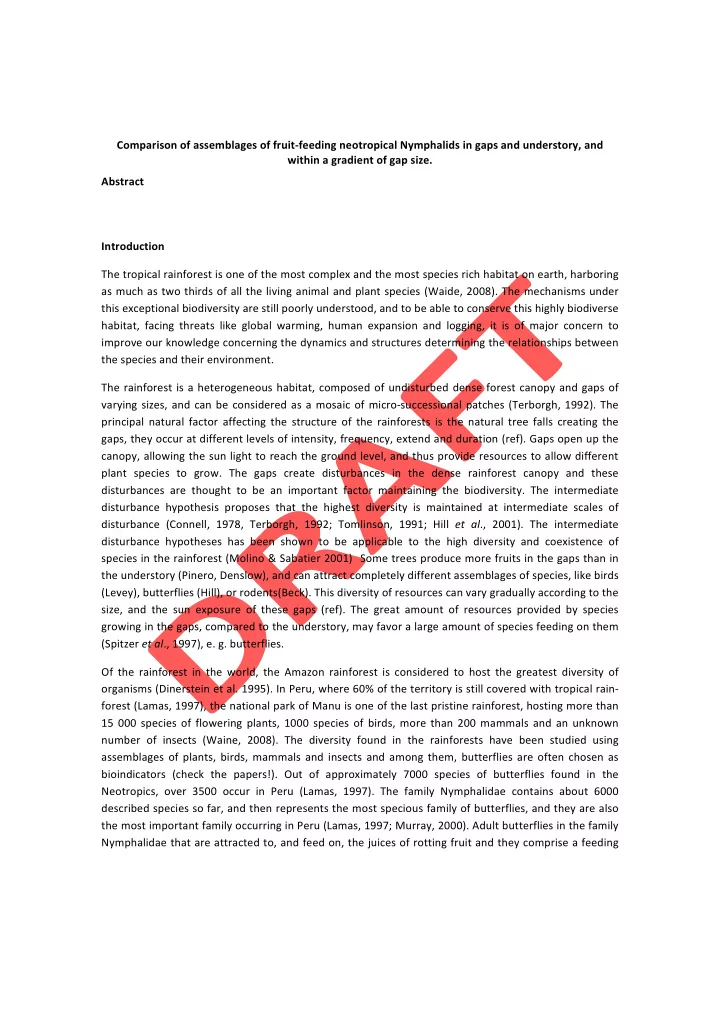

¡ Comparison ¡of ¡assemblages ¡of ¡fruit-‑feeding ¡neotropical ¡Nymphalids ¡in ¡gaps ¡and ¡understory, ¡and ¡ within ¡a ¡gradient ¡of ¡gap ¡size. ¡ Abstract ¡ ¡ ¡ Introduction ¡ The ¡tropical ¡rainforest ¡is ¡one ¡of ¡the ¡most ¡complex ¡and ¡the ¡most ¡species ¡rich ¡habitat ¡on ¡earth, ¡harboring ¡ as ¡much ¡as ¡two ¡thirds ¡of ¡all ¡the ¡living ¡animal ¡and ¡plant ¡species ¡(Waide, ¡2008). ¡The ¡mechanisms ¡under ¡ this ¡exceptional ¡biodiversity ¡are ¡still ¡poorly ¡understood, ¡and ¡to ¡be ¡able ¡to ¡conserve ¡this ¡highly ¡biodiverse ¡ habitat, ¡ facing ¡ threats ¡ like ¡ global ¡ warming, ¡ human ¡ expansion ¡ and ¡ logging, ¡ it ¡ is ¡ of ¡ major ¡ concern ¡ to ¡ improve ¡our ¡knowledge ¡concerning ¡the ¡dynamics ¡and ¡structures ¡determining ¡the ¡relationships ¡between ¡ the ¡species ¡and ¡their ¡environment. ¡ The ¡rainforest ¡is ¡a ¡heterogeneous ¡habitat, ¡composed ¡of ¡undisturbed ¡dense ¡forest ¡canopy ¡and ¡gaps ¡of ¡ varying ¡sizes, ¡and ¡can ¡be ¡considered ¡as ¡a ¡mosaic ¡of ¡micro-‑successional ¡patches ¡(Terborgh, ¡1992). ¡The ¡ principal ¡ natural ¡ factor ¡ affecting ¡ the ¡ structure ¡ of ¡ the ¡ rainforests ¡ is ¡ the ¡ natural ¡ tree ¡ falls ¡ creating ¡ the ¡ gaps, ¡they ¡occur ¡at ¡different ¡levels ¡of ¡intensity, ¡frequency, ¡extend ¡and ¡duration ¡(ref). ¡Gaps ¡open ¡up ¡the ¡ canopy, ¡allowing ¡the ¡sun ¡light ¡to ¡reach ¡the ¡ground ¡level, ¡and ¡thus ¡provide ¡resources ¡to ¡allow ¡different ¡ plant ¡ species ¡ to ¡ grow. ¡ The ¡ gaps ¡ create ¡ disturbances ¡ in ¡ the ¡ dense ¡ rainforest ¡ canopy ¡ and ¡ these ¡ disturbances ¡ are ¡ thought ¡ to ¡ be ¡ an ¡ important ¡ factor ¡ maintaining ¡ the ¡ biodiversity. ¡ The ¡ intermediate ¡ disturbance ¡ hypothesis ¡ proposes ¡ that ¡ the ¡ highest ¡ diversity ¡ is ¡ maintained ¡ at ¡ intermediate ¡ scales ¡ of ¡ disturbance ¡ (Connell, ¡ 1978, ¡ Terborgh, ¡ 1992; ¡ Tomlinson, ¡ 1991; ¡ Hill ¡ et ¡ al ., ¡ 2001). ¡ The ¡ intermediate ¡ disturbance ¡ hypotheses ¡ has ¡ been ¡ shown ¡ to ¡ be ¡ applicable ¡ to ¡ the ¡ high ¡ diversity ¡ and ¡ coexistence ¡ of ¡ species ¡in ¡the ¡rainforest ¡(Molino ¡& ¡Sabatier ¡2001) ¡Some ¡trees ¡produce ¡more ¡fruits ¡in ¡the ¡gaps ¡than ¡in ¡ the ¡understory ¡(Pinero, ¡Denslow), ¡and ¡can ¡attract ¡completely ¡different ¡assemblages ¡of ¡species, ¡like ¡birds ¡ (Levey), ¡butterflies ¡(Hill), ¡or ¡rodents(Beck). ¡This ¡diversity ¡of ¡resources ¡can ¡vary ¡gradually ¡according ¡to ¡the ¡ size, ¡ and ¡ the ¡ sun ¡ exposure ¡ of ¡ these ¡ gaps ¡ (ref). ¡ The ¡ great ¡ amount ¡ of ¡ resources ¡ provided ¡ by ¡ species ¡ growing ¡in ¡the ¡gaps, ¡compared ¡to ¡the ¡understory, ¡may ¡favor ¡a ¡large ¡amount ¡of ¡species ¡feeding ¡on ¡them ¡ (Spitzer ¡ et ¡al ., ¡1997), ¡e. ¡g. ¡butterflies. ¡ ¡ Of ¡ the ¡ rainforest ¡ in ¡ the ¡ world, ¡ the ¡ Amazon ¡ rainforest ¡ is ¡ considered ¡ to ¡ host ¡ the ¡ greatest ¡ diversity ¡ of ¡ organisms ¡(Dinerstein ¡et ¡al. ¡1995). ¡In ¡Peru, ¡where ¡60% ¡of ¡the ¡territory ¡is ¡still ¡covered ¡with ¡tropical ¡rain-‑ forest ¡(Lamas, ¡1997), ¡the ¡national ¡park ¡of ¡Manu ¡is ¡one ¡of ¡the ¡last ¡pristine ¡rainforest, ¡hosting ¡more ¡than ¡ 15 ¡000 ¡species ¡of ¡flowering ¡plants, ¡1000 ¡species ¡of ¡birds, ¡more ¡than ¡200 ¡mammals ¡and ¡an ¡unknown ¡ number ¡ of ¡ insects ¡ (Waine, ¡ 2008). ¡ The ¡ diversity ¡ found ¡ in ¡ the ¡ rainforests ¡ have ¡ been ¡ studied ¡ using ¡ assemblages ¡of ¡plants, ¡birds, ¡mammals ¡and ¡insects ¡and ¡among ¡them, ¡butterflies ¡are ¡often ¡chosen ¡as ¡ bioindicators ¡ (check ¡ the ¡ papers!). ¡ Out ¡ of ¡ approximately ¡ 7000 ¡ species ¡ of ¡ butterflies ¡ found ¡ in ¡ the ¡ Neotropics, ¡ over ¡ 3500 ¡ occur ¡ in ¡ Peru ¡ (Lamas, ¡ 1997). ¡ The ¡ family ¡ Nymphalidae ¡ contains ¡ about ¡ 6000 ¡ described ¡species ¡so ¡far, ¡and ¡then ¡represents ¡the ¡most ¡specious ¡family ¡of ¡butterflies, ¡and ¡they ¡are ¡also ¡ the ¡most ¡important ¡family ¡occurring ¡in ¡Peru ¡(Lamas, ¡1997; ¡Murray, ¡2000). ¡Adult ¡butterflies ¡in ¡the ¡family ¡ Nymphalidae ¡that ¡are ¡attracted ¡to, ¡and ¡feed ¡on, ¡the ¡juices ¡of ¡rotting ¡fruit ¡and ¡they ¡comprise ¡a ¡feeding ¡ ¡
Recommend
More recommend